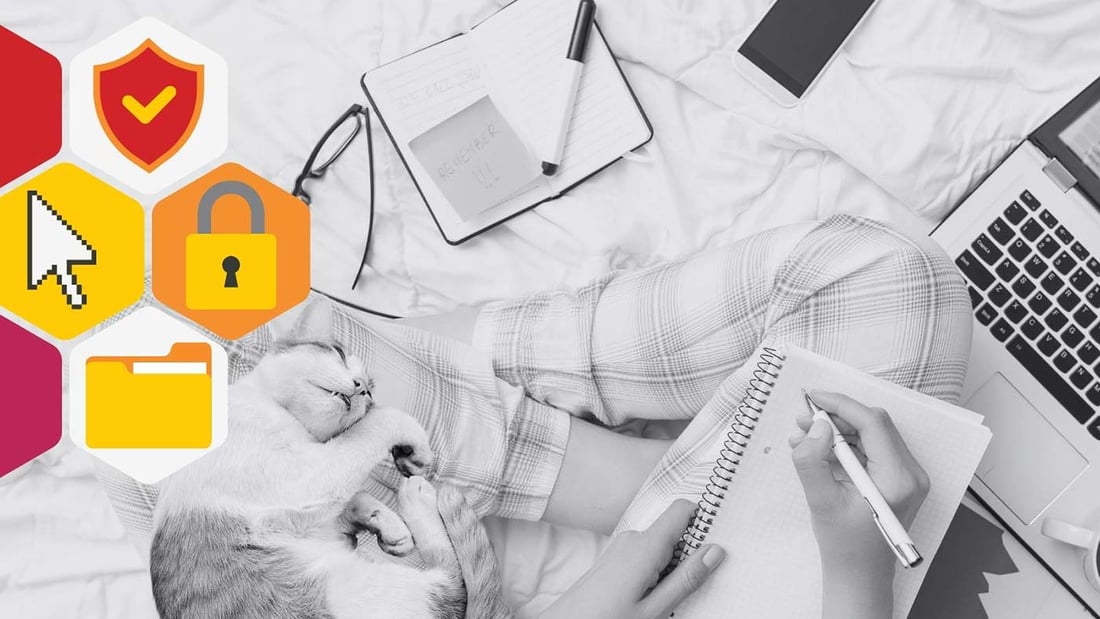The Remote Work Revolution: Navigating Security in a Changing Landscape
The outbreak of COVID-19 reshaped the world in ways we could scarcely have imagined. Beyond its obvious health and social impacts, the pandemic...
![]() Team CM
Oct 24, 2025 8:00:02 AM
Team CM
Oct 24, 2025 8:00:02 AM

In the frenzied sprint toward AI adoption, every enterprise is bolting generative models onto their operations like carbon-fiber wings on a paper airplane. The promise is irresistible—boosted productivity, hyper-personalized customer experiences, automation that writes itself. But as these systems proliferate, something essential is being left behind in the dust cloud of innovation: the human being at the controls.
We say "human-in-the-loop" as if that loop is clearly defined.
But what does it really mean to be the human in that loop? What is the loop? Where does it start, where does it fail, and who takes responsibility when it does?
Most “human oversight” is theater: people are asked to sign off on AI without criteria, context, or authority.
Train for the real loop: inputs, model choice, output judgment, post-processing, feedback—not just step #3.
Align training to risk roles, build judgment skills (spotting hallucinations/deepfakes), and give decision latitude.
Anchor programs to recognized frameworks (NIST AI RMF; EU AI Act Article 14; ISO/IEC 42001) and AI-specific threat models (MITRE ATLAS, OWASP LLM Top 10).
Let's start here. It’s not a checkbox. It’s a defined sequence of human decision gates—from input controls and model choice to output judgment, post-processing, and feedback loops—with clear criteria, authority, and escalation at each step. If any gate is missing (or untrained), oversight collapses into theater.
Welcome to the oversight crisis. And the people you train today—or fail to—will decide whether your AI future is secure or a catastrophe waiting to happen.
The phrase "human oversight" has become the fig leaf of AI governance. Tossed into board decks, compliance checklists, and whitepapers, it's often little more than a performative checkbox to satisfy regulators or auditors. The assumption? If a person is "involved," then the risk is managed.
But let’s be clear: involvement is not the same as informed judgment.
In 2025, most employees tasked with "reviewing" AI outputs are making snap decisions without:
Clear criteria or thresholds
Context on how the model was trained
Understanding of adversarial manipulation risks
Visibility into why the model suggested what it did
This is oversight theater. And it’s dangerously close to rubber-stamping.
Let’s break down the real loop and where human oversight actually makes or breaks security:
Input Oversight: Is the prompt or dataset secure, accurate, and appropriately scoped?
Model Selection: Who decides what model or vendor is used, and are those decisions risk-informed?
Output Judgment: Can humans spot hallucinations, sensitive data leakage, or manipulative language?
Post-Processing: How is AI-generated content validated, edited, or pushed live?
Feedback Loop: Are there structures for reporting issues and improving future outputs?
Most companies are focused only on #3, and even then, they often rely on untrained employees with no time, context, or incentive to go beyond a cursory glance.

Human cognition is flawed. We overtrust automation, underestimate long-term risks, and conform to majority decisions—even if those decisions are wrong. This means:
Bias recognition needs to be trained like muscle memory. Biases are mental shortcuts—cognitive heuristics—that operate below the level of conscious awareness. If not surfaced and challenged regularly, they can lead to dangerous lapses in judgment. Training to spot bias increases cognitive agility and slows down reactive decision-making.
Spotting subtle manipulations—especially with social engineering layered onto AI-generated outputs—requires behavioral pattern recognition. Humans can learn to identify odd language structures, emotional manipulation cues, or context drift, but only with training that builds up these internal 'red flag' detectors.
Resisting overreliance on seemingly competent machines demands a mix of self-awareness, digital literacy, and cultural reinforcement. The automation bias is deeply rooted in trust of system authority—breaking it requires critical thinking practice and explicit permission to question tools.
Interrogating AI intent—humans must develop the reflex to ask: why this output, now, for this use case? Cognitive laziness defaults to acceptance, while mentally active interrogation strengthens executive function and ethical reasoning.
Building friction tolerance—not every oversight moment will be neat or efficient. Training should include resilience and stress-management, helping humans maintain decision quality under speed or ambiguity. Psychological pressure erodes cognitive control, especially under tight operational deadlines.
In short, oversight humans need more than policy slides and annual compliance courses. They need to be retrained as adaptive decision-makers in an environment where speed, scale, and subtlety have all changed.
To actually prepare your people to provide meaningful oversight in the AI era, training needs to evolve across several dimensions:
Every oversight human needs to know why their role matters:
A recruiter using AI to shortlist candidates can introduce discriminatory patterns
A marketer deploying generative copy may accidentally publish copyrighted or biased content
A developer leveraging AI-assisted coding tools could inject vulnerable code into critical systems
Training insight: Overlay AI use cases with risk scenarios that matter for that functional area.
Go beyond “what is AI?” to:
Spotting deepfake content indicators
Identifying hallucinated citations or statistics
Assessing whether an output “feels” off—and giving people permission to act on that intuition
Training insight: Simulations, red team/blue team exercises, and debriefs beat passive modules every time.
If humans are responsible for stopping bad AI outcomes, they need to know:
What their decision space is
What the escalation paths are
That they won’t be punished for slowing down when they spot an issue
Training insight: Psychological safety and clarity of authority must be embedded in policy and practice.
Security culture eats training for breakfast. If the norm is to trust tools blindly, speed through reviews, and avoid asking hard questions, no amount of slide decks will make your oversight humans effective.
Training insight: Leaders must model caution, curiosity, and courage—especially when AI hype is loud.

Map the Loop: Identify every place AI touches human workflows—and vice versa.
Tag the Risk Points: Where are humans essential to stop failure? Where are they most likely to be asleep at the wheel?
Develop Oversight Personas: Different roles need different competencies—this isn’t one-size-fits-all.
Pilot Training Interventions: Choose a high-risk workflow and co-design oversight training with the humans doing the job.
Measure Culture and Competency: Is trust increasing? Are people flagging issues? Do they feel responsible or helpless?
Instrument Feedback Loops: Oversight is only meaningful if issues lead to change. Close the loop.
Overconfidence in security tools has long been a precursor to catastrophic failures—an illusion of safety that blinds organizations to their real exposure. Today, we’re seeing the same misplaced confidence, not in hardened perimeters or firewalls, but in the fallible, untrained humans expected to catch AI missteps in real time. We’re now witnessing a similar overconfidence—this time not in firewalls or zero-days, but in the ability of underprepared people to catch AI failures in real time.
Boards, regulators, and the public are beginning to ask: Who was responsible for this AI decision?
If the answer is “we had human oversight,” be prepared to prove it.
Oversight is not a rubber stamp. It is not an emergency brake. It’s an operating principle. But for it to work, your humans need:
Risk-aligned education
Culture-aligned behavior models
Continuous enablement
Let’s patch HumanOS. Let’s secure the loop.
Want to know how we’re training oversight humans at scale? Talk to our team or follow us on LinkedIn.
Define the loop end-to-end and mark the human decision gates that matter.
Role-based training: tailor oversight skills for recruiters, marketers, developers, etc. (not one-size-fits-all).
Teach judgment, not just policy: deepfake cues, hallucination checks, data leakage flags; practice via sims/red-blue drills.
Grant decision latitude and psych safety so slowing down is allowed when risk is high.
Effective oversight means defined criteria, escalation paths, and authority across the loop: inputs → model choice → output judgment → post-processing → feedback. Frameworks like NIST AI RMF 1.0 describe core functions to Govern, Map, Measure, Manage AI risks.
For high-risk AI, Article 14 requires systems to enable effective human oversight to prevent/minimize risks to health, safety, and fundamental rights; measures can be designed by providers or implemented by users. Artificial Intelligence Act
Adopt an AI management system approach (ISO/IEC 42001) to formalize governance and continuous improvement. Many orgs now certify against 42001 to demonstrate responsible AI practices.
Study MITRE ATLAS (adversary tactics against AI systems) and OWASP’s LLM Top 10 (prompt injection, data leakage, model abuse patterns) to build judgment playbooks and simulations. MITRE ATLAS+1

The outbreak of COVID-19 reshaped the world in ways we could scarcely have imagined. Beyond its obvious health and social impacts, the pandemic...
6 min read

Psst: CISOs and experts, this is one of our beginner-oriented articles! If you're looking for more advanced material, we recommend a dive into the...
3 min read

Cybersecurity doesn’t clock out at 5 p.m. In today’s connected world, your employees’ personal lives have a direct and growing impact on your...
7 min read
Subscribe to our newsletters for the latest news and insights.
Stay updated with best practices to enhance your workforce.
Get the latest on strategic risk for Executives and Managers.